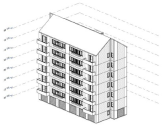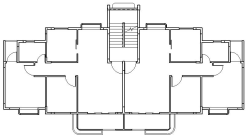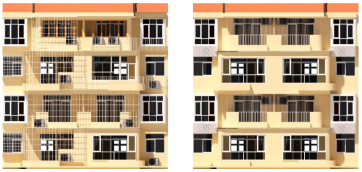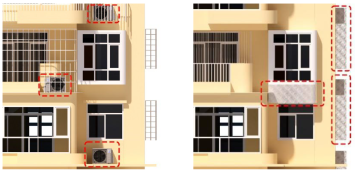Abstract
As renovating existing residential buildings shifts towards more detailed methodologies, conducting comprehensive diagnostic assessments before renovation is crucial for achieving successful outcomes. This research introduces an innovative large-scale diagnostic assessment method for existing residential buildings, addressing the inefficiencies, redundancies, and subjective biases present in traditional diagnostic processes through intelligent assistance modeling. The proposed method focuses on five key elements: construction year, exterior walls, windows, balconies, and shading devices, categorizing assessment levels into four grades (A, B, C, D) based on varying renovation intensities. Evaluation criteria are established for service life, thermal performance, degradation, and aesthetic quality. An intelligent assistance model, constructed using training datasets, enables rapid large-scale assessments, significantly reducing the evaluation time while maintaining an accuracy rate of over 95%. Empirical testing on residential buildings in Shenzhen confirmed the model’s effectiveness, demonstrating its superior accuracy and efficiency compared to traditional methods. A weighted analysis revealed that the impact of each factor on the building’s condition was as follows: exterior wall thickness (0.38), exterior finish deterioration (0.35), window deterioration (0.29), balcony deterioration (0.28), and construction year (0.23). Additionally, an interactive software application integrating the intelligent assessment model was developed. This study employed an interdisciplinary approach, combining machine learning and big data, offering a new perspective on building assessment and providing significant reference value for future residential renovation and urban planning.
1. Introduction
In response to the widespread issue of substandard existing residential buildings, China’s “14th Five-Year Plan” has delineated requirements for quality enhancement and low-carbon renovation at the national level. In recent years, China has witnessed a multifaceted approach to vigorously advancing the renovation of existing residential areas, achieving significant progress in standards, policies, scientific projects, and technological dissemination [1]. However, statistical data from the “China Building Energy Efficiency Annual Development Research Report 2023” reveal that while China’s building area ranges from 400 to 600 billion square meters, urban residential energy consumption ranks first due to the growth in both scale and average energy intensity [2]. In response to the widespread issue of poor quality in existing residential buildings, the government has taken multiple measures in recent years to vigorously promote the renovation of old neighborhoods, leading to ongoing research and practice in this area. Existing research experience indicates that the complete process of renovating residential systems includes preliminary investigation, diagnostic evaluation, decision-making, implementation, and post-renovation follow-up. Among these, diagnostic evaluation is the foundation and key to the success of the renovation. Conducting surveys and diagnostics on a large number of existing residences requires not only increased precision and objectivity but also enhanced efficiency [3]. This presents both new opportunities and challenges with the integration of information and intelligent technologies.
The quality of residential living is determined by multiple factors, including functionality, performance, adaptability to change, and maintenance strategies. International initiatives such as the United Nations’ “2030 Agenda for Sustainable Development”, the American Institute of Architects’ “Architecture 2030”, and the European Union’s “Renovation Wave” emphasize the enhancement of safety, functionality, infrastructure, and environmental quality in residential buildings. Equally important are user perceptions related to comfort, well-being, aesthetic value, and overall quality [4]. The lack of comprehensive data on the current state of large-scale residential areas makes predicting housing performance a challenging task, often relying heavily on subjective factors such as stakeholder experience and judgment [5,6]. Developed countries initiated research on diagnostic evaluation of existing residential buildings earlier, focusing on thorough preliminary investigations to establish comprehensive diagnostic and assessment databases and operational procedures for proposing rational renovation schemes [7,8]. Previous studies have compared diagnostic assessments, participation methods, existing issues, auxiliary tools, and sustainable technologies in residential renovations across various case studies, highlighting the critical role of status diagnosis and stakeholder involvement [9,10]. A two-stage diagnostic approach for existing residences has been proposed, consisting of an initial diagnosis (survey organization, questionnaires, visual inspection) and a secondary diagnosis (physical investigation and experimentation) [11]. The research further revealed that only 17% of maintenance interventions were based on the physical deterioration of buildings, while 44% were driven by subjective criteria [12]. Additionally, two key aspects affecting residential buildings—physical deterioration and aesthetic concerns—were explored, indicating that changes in aesthetic preferences often influence renovation decisions [13,14]. Generally, building components are replaced before their service life ends, highlighting a maintenance approach based on obsolescence rather than aging [15,16].
The construction industry is currently entering the 4.0 era, characterized by intelligent technologies at its core, where smart construction techniques are being integrated with research on improving the quality of existing residential buildings. Recent technological advancements, including advanced sensor technologies, big data analytics, and artificial intelligence methods, enable real-time acquisition and comprehensive analysis of building and environmental data [17]. The critical information elements of existing residential buildings are typically expressed in textual and visual formats. Different machine learning algorithms are employed to process these distinct forms of data. For image classification, convolutional neural networks (CNNs) [18,19,20], decision trees [21,22], and random forest algorithms [23,24] are commonly utilized, while for text classification, deep neural networks (DNNs) [25,26] and K-nearest neighbor (KNN) [27] algorithms are often preferred. However, despite the widespread application of these new technologies in the design, construction, and operation phases of existing residential building renovations, the preliminary planning and diagnostic evaluation stages remain relatively traditional and fragmented.
This research aimed to develop an intelligent assistant model to overcome the limitations of existing methods and enhance the efficiency, accuracy, and objectivity of evaluations. The goal was to create a machine-learning-based intelligent assistant model for the detailed diagnostic evaluation of existing residential buildings. We sought to achieve our objectives by (1) integrating data indicators across multiple dimensions, such as building functionality, performance, adaptability, and aesthetics, to formulate a combined qualitative and quantitative evaluation framework, providing detailed assessment results; (2) utilizing machine learning algorithms to automatically grade the aging level of residential building facades, significantly improving evaluation efficiency; (3) developing a user-friendly interactive software application, enabling non-experts to easily conduct evaluations; furthermore, the model’s accuracy was ensured through dataset training, localization of parameters, expert validation, and self-assessment; (4) conducting broad empirical testing within Shenzhen’s diverse architectural environment, which validated the model’s applicability and accuracy; (5) and making a significant improvement on existing methods. Compared to traditional approaches, the intelligent assistant model demonstrates substantial enhancements in evaluation efficiency, accuracy, and objectivity, which is particularly crucial in the renovation of large-scale residential areas. This innovative approach will provide data-driven decision support for the renovation of existing residential buildings, contributing to a more efficient and objective evaluation process.
The structure of this paper is as follows: Section 2 provides a comprehensive literature review related to the proposed methodology; Section 3 details the methodological framework; Section 4 presents the case study used for validation purposes; and, finally, Section 5 summarizes the key conclusions and outlines future research directions. This structured approach ensures a logical progression from theoretical foundation to practical application, facilitating a clear understanding of the development, implementation, and impact of the intelligent assistant model on the diagnostic evaluation of existing residential buildings.
2. Literature Review
This section provides a critical examination of current research in building renovation assessment and intelligent-assisted models in architecture. Through a thorough analysis of existing methodologies and their limitations, we aim to highlight the research gaps that our study addresses, with a particular focus on large-scale residential buildings in China.
2.1. Evaluation of Building Renovation Strategies and Pre-Assisted Decision-Making
Recent years have witnessed significant developments in the field of building renovation assessment; however, challenges persist, especially in large-scale applications. Jarosław Szulc’s [28] comprehensive study on over 400 buildings in Poland established the crucial groundwork for diagnostic methods in large-panel structures. While groundbreaking, this approach proves resource-intensive and challenging to scale for widespread use, particularly in rapidly developing urban areas like those in China.
Through an extensive literature review, Sanduni Peiris [29] identified building renovation performance assessment as a key research area. This finding underscores the critical need for effective assessment tools, especially in determining the success of renovation projects. Building on this, Pilar Mercader [30] developed a multi-dimensional decision support system for high-rise residential buildings. Their weighted model, incorporating 12 indicators across technical, social, economic, and environmental dimensions, represents a significant step towards holistic assessment. However, its complexity limits its applicability in rapid, large-scale evaluations necessary for China’s urban renewal projects. Anne N. [31] categorized existing decision support tools into six domains: setting sustainability goals, weighting criteria, building diagnostics, generating design alternatives, evaluating performance, and assessing design alternatives. This categorization reveals the multifaceted nature of renovation assessment while highlighting the lack of integrated, user-friendly tools for comprehensive evaluation. In the realm of heritage buildings, Blanca Tejedor [32] applied non-destructive techniques (NDTs) and advanced modeling technologies. While these technical tools aim to provide a deeper understanding of a building’s overall condition, their implementation methods are often complex, time-consuming, and demand high levels of professional expertise from users. Consequently, they are unsuitable for large-scale residential buildings and fail to provide users with a clear understanding of the current housing status or facilitate the development of satisfactory renovation proposals. Moreover, traditional methods struggle with efficiency and scalability when addressing the evaluation needs of large-scale residential areas.
Organizing the diagnosis methods related to the objectives of this study as shown in Table 1 helped to highlight recent advances and identify research gaps that need to be addressed. A critical analysis of the literature revealed several key challenges in current assessment methodologies: Complexity and Time Intensity: Most existing tools, while comprehensive, are often too complex and time-consuming for practical application in large-scale urban renewal projects. High Expertise Requirements: The implementation of current assessment methods typically demands a high level of professional expertise, limiting their widespread use. Limited Scalability: Many tools are designed for individual buildings or small-scale projects, rendering them unsuitable for the large-scale residential complexes common in Chinese cities. Contextual Limitations: Assessment systems developed in Western countries often focus on low-rise villas with well-established construction standards, making them difficult to apply directly to China’s large-scale collective housing projects with different social and technical aspects. Lack of Integrated Approaches: While quantitative algorithms have improved, they often fail to incorporate qualitative factors such as resident satisfaction and cultural considerations.

Table 1.
Diagnostic evaluation studies in developed countries.
2.2. Status of Artificial Intelligence—Aided Modeling in Architecture
Recent advancements in BIM and AI offer promising avenues for addressing some of these challenges. Rebekka Volk’s [33] comprehensive review highlighted the underutilization of BIM in existing building renovations compared to new constructions, indicating significant potential for growth in this area. Stephen Fai [34] demonstrated the advantages of BIM in cultural heritage documentation, showcasing its superior geometric modeling and visualization capabilities. However, the application of these techniques to large-scale residential complexes remains largely unexplored. Hamidreza Alavi [35] proposed an integrated data model for building condition risk assessment within BIM, addressing interoperability issues. While innovative, this approach still requires adaptation for large-scale residential evaluations. Par Johansson [36] emphasized the critical importance of baseline information surveys and diagnostics in residential renovation projects through an extensive review of the literature and case studies. While these technical tools aim to provide a deeper understanding of building conditions, their implementation often proves complex, time-consuming, and demanding in terms of user expertise. Consequently, they fall short of providing users with clear insights into current housing conditions and satisfactory renovation proposals. Previous studies have explored automated solutions for facade stain diagnosis [37,38,39], but these approaches are predominantly applicable to single buildings and unsuitable for large-scale aging residential complexes in China.
Our study addresses several key research gaps identified in the literature: Scalability: We propose a method suitable for large-scale residential complexes, addressing the limitations of existing tools designed for individual buildings. Efficiency: By leveraging text information classification algorithms over image recognition techniques, our approach offers a more efficient and flexible solution for multi-label, multi-dimensional assessments. Contextual Relevance: Our methodology is specifically tailored to the unique characteristics of Chinese urban housing, addressing the contextual limitations of Western-developed systems. Integration of Qualitative and Quantitative Factors: Unlike purely quantitative approaches, our method incorporates both objective measurements and subjective factors like resident satisfaction. Accessibility: By utilizing deep neural networks (DNNs), our approach reduces the high expertise requirements of current methods, making it more accessible for widespread use. In conclusion, while significant progress has been made in the informatization and intelligentization of residential renewal, there remains a critical need for refined, efficient, and scalable diagnostic evaluation methods. Our study aims to fill this gap by proposing an innovative approach that leverages advanced technologies while addressing the unique challenges of large-scale residential assessment in the Chinese context.
3. Methodology
3.1. Diagnostic Evaluation Process Based on Intelligent Assistive Modeling
In the field of existing residential regeneration, diagnostic evaluation has evolved from primarily qualitative Phase 1.0 to the combined qualitative and quantitative Phase 2.0 (Figure 1). Despite the progress made during this evolution, limitations such as low efficiency, high subjectivity, and insufficient refinement of processes persist. In response, this paper proposes Phase 3.0 of diagnostic evaluation—a process based on an intelligent auxiliary model aimed at fine-tuning management processes to optimize quality, increase efficiency, and reduce costs. It is important to note that this study involved interdisciplinary collaboration with a team specializing in computer engineering. The partner team was responsible solely for the machine learning code development and interactive app creation, while the authors handled the construction of the intelligent evaluation framework, formulation of evaluation rules, and dataset creation.
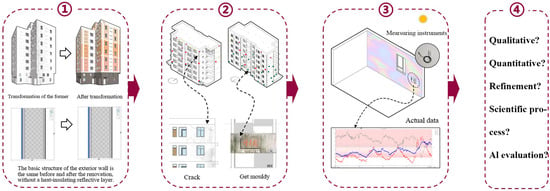
Figure 1.
Domestic diagnostic evaluation research. (①: diagnostic evaluation Phase 1.0; ②&③: diagnostic evaluation Phase 2.0; ④: diagnostic evaluation Phase 3.0.)
The diagnostic evaluation process based on an intelligent auxiliary model can be divided into five key stages (Figure 2): fine data collection, multi-source data integration, current condition diagnosis, pre-renovation evaluation, and regeneration design decision-making. In this study, the fine diagnosis encompassed the first three stages, while the intelligent evaluation was central to the pre-renovation evaluation. The stages of data collection and integration leveraged advanced information technologies to supplement traditional survey methods, enhancing the comprehensiveness of information and survey efficiency. The current condition diagnosis stage combined qualitative and quantitative diagnoses to form more accurate diagnostic opinions. The pre-renovation evaluation stage incorporated machine learning technology to enhance the objectivity and efficiency of evaluations. Finally, regeneration design decisions were based on the diagnostic and evaluation results, with evaluation outcomes guiding renovation strategies and diagnostic results informing specific renovation measures. These five stages constituted a comprehensive fine-tuned diagnostic evaluation process, achieving precision through the integration of information flow and data continuity.

Figure 2.
Intelligent diagnostic assessment process.
In the intelligent assistant model proposed in this paper, Figure 3 illustrates the process of assigning maintenance grades to each building renovation project. The intelligent evaluation focuses on individual residential buildings, encompassing the entire process from diagnostic input to the output of intelligent evaluation grades and design decision references. The framework is divided into three key components: the input phase, the machine phase, and the output phase (Figure 3). In the input phase, the intelligent evaluation system receives multi-level diagnostic information on existing residences, including construction age, structural systems, facade systems, equipment systems, interior systems, and public spaces. The critical task at this stage is to ensure the acquisition of accurate and comprehensive data on the basic characteristics of existing residences, providing reliable data support for subsequent machine-phase evaluations. The machine phase, as the core of intelligent evaluation, utilizes machine learning techniques to learn from expert experiences, such as rules for aging and deterioration grading, standards for renovation strategy classification, renovation methods, priority orders for renovations, and regulatory standards. The output phase primarily generates evaluation grades for various levels of existing residences. The system ranks the renovation priorities according to these grades, aiding in the selection of elements to prioritize under limited funding. More importantly, it outputs a renovation strategy and a toolkit of renovation measures corresponding to each evaluation grade, achieving a one-stop diagnostic evaluation. The facade serves as the external image of a residence, reflecting the occupants’ individuality and influencing the property’s asset value. Therefore, in existing renovation projects, the facade of existing residences often becomes a focal point. This research begins with the intelligent evaluation of residential facades as the first step in developing the intelligent evaluation model. The process aims to serve as an advanced demonstration and visionary model for future practices in the regeneration of existing residences.
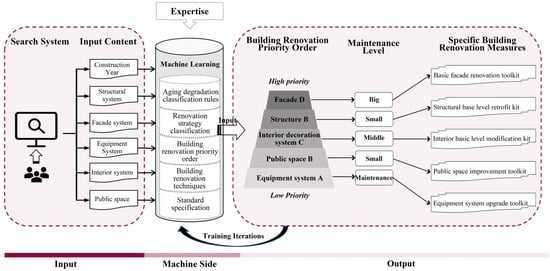
Figure 3.
Basic framework for intelligent assessment.
3.2. Selection and Definition of Key Elements
Research indicates that urban renewal projects in China, particularly those focusing on facade systems, constitute over 60% of specialized renovation efforts. Given the high urgency for such renovations, this article begins by examining facade systems as a primary example of urban renewal initiatives. In the transformation of existing residential buildings in regions with hot summers and warm winters, the primary focus should be on passive design strategies to reduce air-conditioning energy consumption. Priority should be given to enhancing the thermal insulation and shading performance of exterior windows [40], improving the thermal insulation of west-facing walls, and simultaneously optimizing natural ventilation conditions. Controlling the solar heat gain coefficient of exterior windows can significantly affect the amount of solar radiation entering the interior, thereby influencing the building’s energy consumption. Based on the literature [41,42], five key factors were identified that significantly impact the energy consumption of existing residential buildings in Shenzhen: construction era, exterior wall structure, exterior window type, balcony design, and shading method (Figure 4). These factors were used to develop a hierarchical renovation scheme (Table 2). Additionally, thermal insulation performance indicators were extracted from the “Design Standard for Energy Efficiency of Residential Buildings in Hot Summer and Warm Winter Regions”.

Figure 4.
Elevation evaluation objects.

Table 2.
Diagnostic indicators for key elements.
3.3. Data Collection and Integration
The intelligent model, essential for data recording and visualization on diagnostic evaluation platforms, faces unique challenges with existing buildings due to data capture and lifecycle updates [43]. When original building drawings are available and clear, manual modeling using information modeling software is feasible. For missing or outdated drawings, 3D laser scanning and aerial surveys provide a point cloud model for reverse modeling. This approach integrates real-state data and a deterioration phenomena database, allowing for the overlay of missing information and renovation history, thereby enabling a comprehensive, iterative visualization of residential deterioration, diagnosis, and repair [44] (Figure 5).
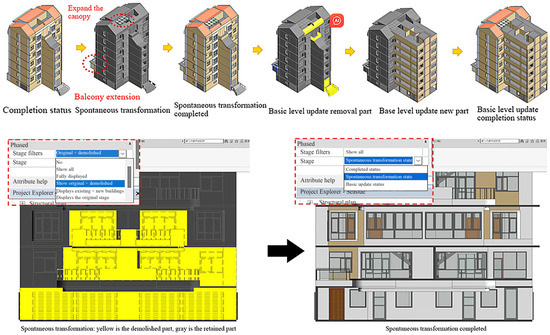
Figure 5.
BIM staged model demonstration.
The primary functions of BIM are integration and visualization [45], which can be used for multiple purposes and over an extended period. This model is utilized throughout all stages of residential regeneration. In this experiment, Revit was the software employed for BIM modeling. The specific steps are as follows: (a) Perform hierarchical base modeling, dividing the model into structural systems, envelope systems, interior systems, and equipment systems. (b) Input non-geometric attributes, integrate material information of a specific residence, and mark deteriorated areas with corresponding real-world images. (c) Conduct phased modeling, where the multiple maintenance records of a residence are presented in 3D, such as rooftop canopy installations, balcony expansions, elevator additions, and partial structural augmentations. These records are saved in different phases within the Revit model, allowing the display of various stages by selecting the corresponding phase. (d) Create design option models, such as multiple shading options for exterior windows. Selecting different design options will display various effects and automatically generate corresponding cost tables, providing valuable references for subsequent renovation design decisions. While the initial investment may be higher, in the long run, it can significantly improve efficiency, and reduce errors and rework, thereby saving time and costs. BIM can be utilized throughout the entire project life cycle, providing valuable data support for subsequent maintenance, renovation, and management [46]. BIM technology also has a high degree of scalability—even in resource-constrained regions, simplified BIM tools and processes can be adopted. Numerous open-source and low-cost BIM solutions are constantly emerging, making this technology more prevalent and accessible. BIM is not used in isolation but can be combined with other technologies and methods, such as drone surveying and 3D scanning. It can also serve as a central platform to integrate multiple data sources and analytical tools [47].
3.4. Classification of Assessment Levels and Rulemaking
Formulating intelligent evaluation rules for regenerating existing residential buildings encompasses three main tasks: grading criteria definition, indicator selection, and rule establishment. Different building components require specific indicator selections for intelligent evaluation rules. For instance, in evaluating the deterioration of exterior facades of existing residential buildings, both performance and appearance beauty are crucial dimensions impacting facade quality improvement. Based on these two dimensions, this study selected three objective indicators—transformation intensity, service life, and thermal properties—and two subjective indicators—degree of damage and appearance of beauty. From these, seven diagnostic points and their pathological symptoms were identified (Figure 6).
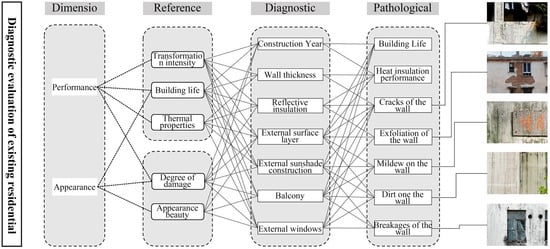
Figure 6.
Identification of reference indicators and diagnostic points.
The aging degree of existing residential buildings determines their regeneration design strategies. This study categorized regeneration strategies based on renovation intensity into four types: maintenance, minor repair, medium repair, and major repair. Corresponding renovation methods include cleaning, repair, addition, and replacement. Cleaning can be performed using physical or chemical methods; repairs aim to restore the performance and functionality of deteriorated areas; additions refer to incorporating new elements into existing structures; and replacement involves the complete substitution of the enclosure structure.
For the classification of maintenance management levels of residential buildings, Professor Matsumura [48] from Japan divides them into four levels based on different renovation intensities [49]. Taking the classification of the deterioration degree of exterior facades as an example, since the regeneration target is the exterior facade, specific measures generally include cleaning (wall cleaning, component cleaning, etc.), repair (facade painting, component repair, surface patching, etc.), addition (adding shading components, thermal reflective layers, raising railings, adding air conditioning unit covers, etc.), and replacement (replacing exterior windows, railings, shading devices, and surface finishes). Based on different renovation intensities, the evaluation grades for the deterioration degree of existing residential facades are divided into four levels: A, B, C, and D (Table 3). The renovation intensity increases progressively from grade A to D, with typical cases illustrated in Table 4.

Table 3.
Key element diagnostic indicator parameters and levels.

Table 4.
Detailed description of assessment levels.
In this paper, we demonstrate the proposed intelligent auxiliary model’s significant advancements in the diagnostic evaluation of residential buildings, particularly in assessing renovation intensity and classifying evaluation grades, compared to traditional methods. Conventional evaluation approaches often rely heavily on experts’ subjective judgments, utilizing standardized scorecards or checklists. While detailed, these methods can lead to inconsistencies in evaluation results due to differences in individual experience and interpretation. Additionally, some traditional methods may focus excessively on quantitative data, overlooking the qualitative aspects of a building’s functionality, aesthetics, and sociocultural value. In contrast, the intelligent auxiliary model adopts an innovative evaluation approach that integrates both qualitative and quantitative assessment techniques. Leveraging machine learning and big data analysis, this model not only processes and analyzes vast amounts of historical and real-time data but also considers the specific conditions and unique needs of each building. This provides a reference for future more precise renovations tailored to individual buildings. When evaluating renovation intensity, the model takes into account the building’s physical characteristics—such as the thickness of external walls, presence of reflective insulation, service life, extent of damage, and aesthetic appeal—and provides a range of renovation suggestions, from simple maintenance to major repairs, based on a comprehensive analysis of these factors. Regarding the classification of evaluation grades, the intelligent auxiliary model employs a refined set of indicators, offering more precise guidance for external wall renovations by subdividing evaluation grades into categories such as A1 to D1. This grading not only considers quantitative data, like thermal performance metrics of the walls, but also incorporates qualitative factors such as aesthetic appeal. This multifaceted approach enables the model to deliver more personalized and dynamic evaluation results, thereby enhancing the decision-making process. The model reduces user barriers by offering more visualized and dynamic evaluation results through a comprehensive assessment approach. This enhancement increases the scientific rigor and participatory nature of the decision-making process.
Overall, the intelligent auxiliary model presents a scientifically robust and comprehensive new method for assessing renovation intensity and classification. Combining the precision of quantitative analysis with the thoroughness of qualitative evaluation, it overcomes the limitations of traditional methods, offering a more effective and reliable tool for the diagnostic evaluation of residential buildings.
3.5. Construction of Intelligent Auxiliary Model and Interaction App Design
The development of the intelligent evaluation algorithm model for existing residential buildings involves seven main steps (Figure 7): data preparation, feature engineering, model construction, model training, model evaluation, tuning and optimization, and model deployment. Taking the development of a DNN algorithm model as an example, the process is divided into two parts: training and prediction.
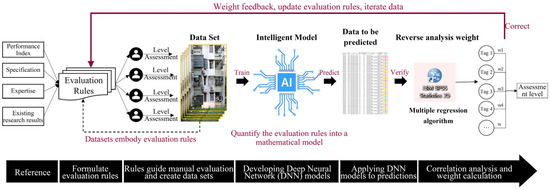
Figure 7.
Intelligent model development logic.
To construct a comprehensive and representative dataset, this study identified 12 diagnostic points based on those above five key elements, further divided into 42 sub-labels (Table 2). These sub-labels were combined across the 12 evaluation tags, resulting in 362,880 unique combinations, each representing a different scenario of facade deterioration in existing residential buildings, effectively covering the spectrum of potential deterioration cases. Given the vast number of combinations, the integration of machine learning was crucial for model development. Initially, three experts were invited to evaluate each combination according to established criteria rigorously. The number of evaluated combinations for each element was as follows: 2025 for walls, 1017 for windows, 765 for balconies, and 1017 for shading devices. The hierarchical sampling of 1400 combinations representing the overall condition of the residential buildings was then continued for grade assessment and finally calibrated with random data sampling. This base dataset was the initial training material for constructing the model.
In the algorithm development process (Figure 8), an automated data-reading program was established, enabling the algorithm model to automatically access data tables stored in the corresponding computer folders. Upon reading the dataset, the algorithm divides it into a training set and a test set, with the split ratio adjustable as needed. For this experiment, the dataset was divided into an 8:2 ratio, which aids in validating the model during the training process to ensure it generalizes well rather than simply overfitting to the training data. After the dataset is imported into the algorithm model, the computer automatically encodes the text data and trains the model based on the provided dataset. The intelligent evaluation model learns the mathematical relationships between data points through multiple training iterations. Through these steps, the model is refined through manual calibration and extensive data learning and iteration. In this experiment, the K-nearest neighbors (KNN) algorithm and the deep neural network (DNN) algorithm were utilized, achieving evaluation accuracies of 88.8% and 94%, respectively. This experiment represents an effort to build on the foundations of qualitative and quantitative diagnostic assessments, with further refinement of the principles and model still needed.

Figure 8.
Evaluating the rule validation process.
The core step of the self-check for the training dataset involves using the initial training dataset to train the intelligent evaluation model. The trained model is then used to predict the evaluation results for the same dataset (Figure 9). Inconsistent evaluation results are filtered and compared using Excel, allowing for the correction or optimization of evaluation rules and enhancing the accuracy of the evaluation model.
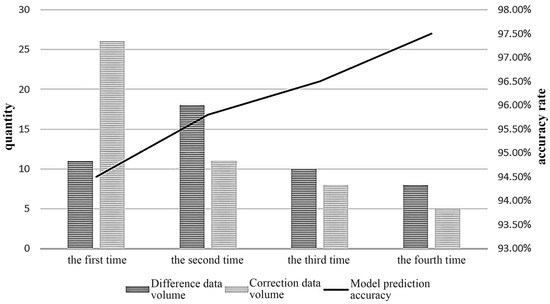
Figure 9.
Changes in indicators after multiple rounds of revisions.
To further verify the accuracy of the evaluation rules, this study employed SPSS software (version number 25.0) to conduct correlation analysis on the dataset, aiming to determine the correlation between various evaluation factors and the deterioration degree of exterior facades. We used the experiment set “evaluation grade” as the dependent variable and seven evaluation factors, including “construction year” and “wall thickness”, as independent variables, with a dataset of 1400 samples. The residual histogram from the analysis clearly shows a normal distribution (Figure 10), indicating strong sample representativeness and a good model fit.
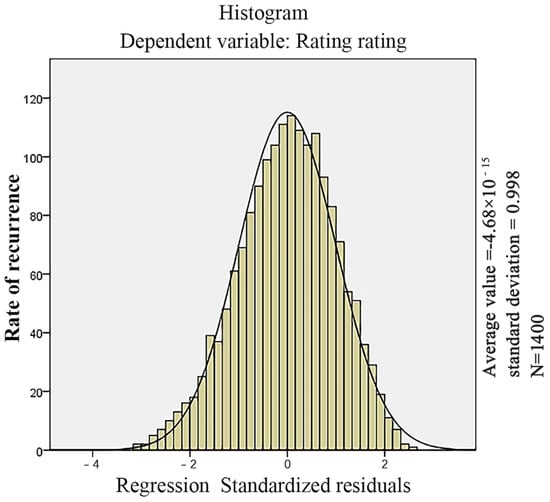
Figure 10.
Histogram of residuals.
The Pearson correlation heatmap analysis (Figure 11) revealed that the correlation coefficients of the evaluation factors with the grading level were ranked as follows: wall thickness (0.38) > exterior surface deterioration degree (0.35) > window deterioration degree (0.29) > balcony deterioration degree (0.28) > construction year (0.23) > presence of fixed external shading components (0.10) > presence of reflective insulation layer (0.05). This result shows that wall thickness, exterior surface deterioration degree, windows, balconies, and construction year have significant impacts on facade deterioration grading. This result supports the previous research hypothesis and statistically verifies the reasonableness of the evaluation rules. It is important to note that correlation coefficients only partially reflect the impact of evaluation factors on grading levels and do not directly indicate the importance of a factor for renovation quality improvement. For instance, while the presence of reflective insulation layers and fixed external shading components have a minor impact on grading levels, they significantly improve the thermal properties of facades.
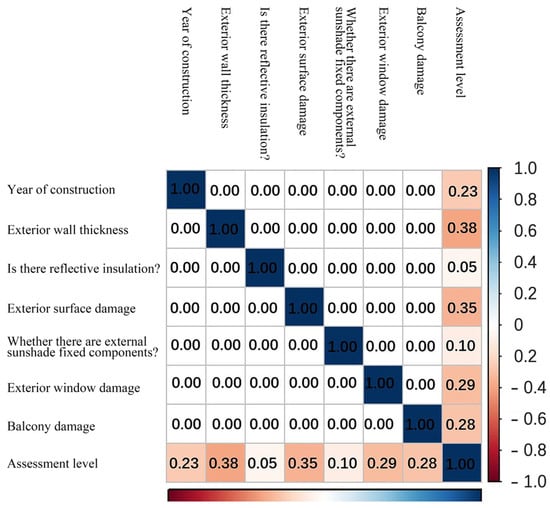
Figure 11.
Pearson correlation coefficient heat map.
To further enhance the usability of the intelligent evaluation model, this study designed a visualization application software with an interactive interface—the Intelligent Evaluation APP. The core design concept of this app is to simplify the technical operation process through a user-friendly interface, allowing users, including non-experts, to easily conduct assessments of existing residential buildings.
The core of the Intelligent Evaluation APP is driven by the DNN algorithm-based intelligent evaluation model. On this basis, an intuitive and user-friendly interactive interface was developed. The interface features a clear navigation menu and flexible drop-down options, with preset search options for various evaluation factors, enabling users to quickly set parameters for diagnosing the condition of existing residential buildings (Figure 12). For example, if users need to evaluate a building constructed in 1985, they can select the “1980–1992” period from the drop-down menu as the assessment condition. Additionally, the app provides a wealth of case studies and reference materials tailored to users’ needs. The display of actual cases not only deepens users’ understanding of the assessment process but also aids in making more accurate decisions when selecting evaluation factors. Each option is accompanied by a help icon linked to detailed explanations and relevant cases, ensuring that even first-time users can quickly get started and perform effective assessments.

Figure 12.
App interactive interface.
In the visualization app, the Revit software API (version 2022) is utilized to access the pre-existing residential BIM model. By bypassing the relevant element IDs—such as exterior walls, windows, and balconies—through the API, an information window is triggered, displaying detailed assessment data for the selected element. These data include technical parameters extracted from the BIM model, such as material properties and dimensions, which are then displayed on the right side of the app interface. This integration method not only makes the assessment process more intuitive and efficient but also ensures that the assessment data remain synchronized with the BIM model, providing a comprehensive and accurate foundation for subsequent analysis and decision-making. Users can easily switch between different elements, quickly accessing and comparing the condition of various building components, thus offering strong support for the planning and implementing of building renovation projects.
4. Case Study—Residence A in Shenzhen as an Example
Taking Shenzhen, a representative city in hot summer and warm winter regions, as an example, data from the Shenzhen Statistical Yearbook 2021 reveal that, due to its limited urban area and rapid development [50], Shenzhen’s residential construction peaked as early as 2003. This led the city to enter the era of stock housing prematurely and forced it into high-density residential development. A large number of old multi-story brick–concrete residences built between 1980 and 2000 are concentrated in the “inside” area of Shenzhen, where surrounding facilities are well-developed, public services are comprehensive, and transportation is convenient, but energy consumption is high. Therefore, the energy renovation of old residences is a crucial component in supporting China’s low-carbon development strategy [51].
4.1. Selection of Research Subjects
Preliminary research on 93 existing residential buildings in Shenzhen led to the classification and statistical analysis of building forms (Table 5), with one-story, two-house brick–concrete structures being the most prevalent (35.48%). Data from the Shenzhen Municipal Bureau of Statistics show that before 2000, the average number of floors in Shenzhen’s residential buildings was 6–10 floors. Based on this, a typical southern residential unit prototype was selected as the “basic unit” for study. Basic unit data are shown in Table 6, and enclosure structure construction and parameters are detailed in Table 7.

Table 5.
Statistics of existing residential survey.

Table 6.
Information on the study population.

Table 7.
Enclosure construction.
4.2. Diagnosis of the Current Status of the Case
The residential building constructed in 1996, with less than 30 years of use, and previously maintained with exterior wall painting in 2014, shows relatively good maintenance (Table 8). The wall thickness is 180 mm, with standard plastering and no insulation layer, resulting in inadequate thermal properties. However, the north and south facades feature bay windows, while the east and west facades have gables with few openings, effectively reducing direct sunlight exposure. Overall, the building meets basic requirements. The exterior finishing layer shows small cracks and localized dirt but remains largely intact and aesthetically pleasing. The windows are in good condition and function properly, and some have been replaced by residents. Most balconies have been converted to enclosed types, and railings and other components are complete and safe. Overall, the building performs adequately in terms of service life, thermal properties, and appearance beauty, but there is room for improvement (Figure 13). Future renovations could consider using new insulation materials to enhance thermal properties while preserving the building’s appearance [52,53,54]. This comprehensive diagnosis provides a solid information foundation for subsequent intelligent evaluations and renovations, aiding in the development of targeted renovation plans to improve overall building performance and livability.

Table 8.
Diagnostic conclusions of the current situation.
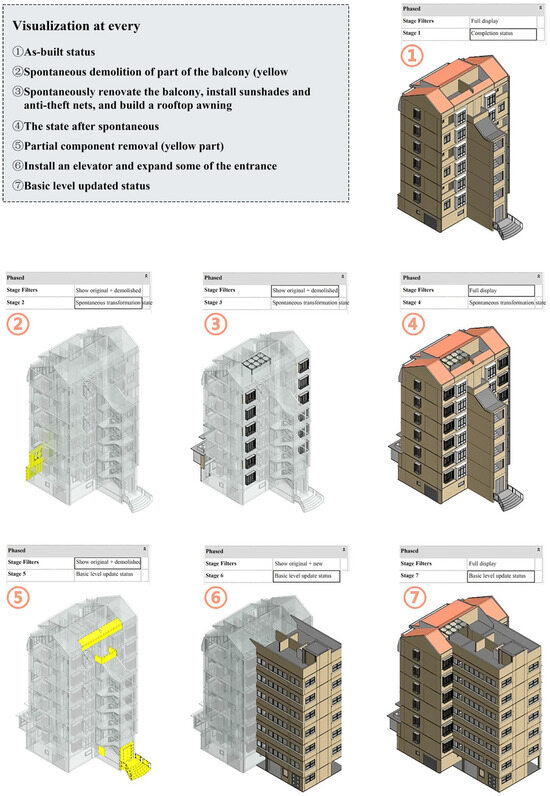
Figure 13.
Staged modeling of an existing residence.
4.3. Intelligent Assessment Results and Analysis
For the intelligent evaluation of residential building A, the foundational information is derived from detailed diagnostic results. The fine diagnosis relies primarily on manual completion, while the evaluation phase utilizes the intelligent model to perform a comprehensive assessment based on these detailed diagnostics. During the facade fine diagnosis process, detailed diagnostic conclusions were obtained for fourteen key factors of the residential building: construction year, wall thickness, reflective insulation layer, exterior finishing layer, external shading components, windows, and balconies. These diagnostic conclusions are directly inputted into the interactive interface of the intelligent evaluation model. By selecting the corresponding options, this information is fed into the model. The intelligent evaluation model then performs efficient analysis and computation based on the input data, ultimately providing a rapid assessment of the facade deterioration level. In the current experiment, the facade deterioration assessment level for the residential building was output as B (Figure 14).

Figure 14.
Intelligent diagnostic assessment results.
The assessment of the facade deterioration level for the residential building shows that both the manual and intelligent evaluations result in a B grade, confirming the feasibility and accuracy of the intelligent evaluation model. The model, based on machine learning, enhances prediction capability through multiple training iterations and achieves end-to-end data matching, significantly improving evaluation efficiency. However, the accuracy of the model is influenced by the quality of the evaluation rules and the accuracy of the training data. To continuously optimize the model, a feedback mechanism should be established to incorporate new data obtained from actual renovation processes. This intelligent evaluation method not only greatly reduces evaluation time but also provides a more efficient and accurate decision-support tool for facade regeneration of existing residential buildings, contributing to the advancement of intelligence in the building renovation field [55,56].
4.4. Exploration of Regeneration Design Decisions
The assessment grade provides a basis for selecting regeneration strategies, and the diagnostic results guide the choice of specific measures [57]. The residential building in question, with a facade assessment grade of B, indicates that the current condition of the building is relatively good and it remains functional. However, there is still room for improvement in appearance beauty and thermal comfort. Given that the building has already had an elevator installed, a large-scale overall renovation is not suitable. Instead, a localized quality enhancement approach, such as minor repairs, is more appropriate [58]. The building is located within a well-facilitated residential area with convenient transportation and is currently partly rented and partly owner-occupied, meaning the requirements for facade specification are not stringent. For facade regeneration measures, a comprehensive upgrade is recommended [59], which can enhance both indoor thermal comfort and appearance beauty (Table 9).

Table 9.
Improvement-type retrofit measures.
For the “minor repair” quality enhancement strategy, the focus is on improving the exterior finishing, external shading components, and the cleanliness of balconies [60]. Specific actions include washing and cleaning the exterior finishing, repairing cracks, and applying reflective insulation coatings; repairing and uniformly painting external shading components, and installing new components where they are missing; enhancing balcony cleanliness, and uniformly replacing security grilles or installing glass curtain walls on enclosed balconies. The renovation design takes into account the building’s duplex characteristics, with facade treatment standardized to two layers, requiring the removal of all security grilles and some spontaneously modified balcony components [61,62]. This renovation plan is more cost-effective and quicker than a large-scale overhaul, providing significant improvements in facade appearance and thermal comfort, while addressing both resident needs and facade cleanliness (Table 10).

Table 10.
Design decision exploration.
5. Conclusions and Future Outlook
This research has achieved significant results on both theoretical and practical levels, successfully constructing the Diagnostic Evaluation 3.0 framework and validating the effectiveness of a refined diagnostic evaluation method through quantitative analysis.
Under the guidance of the intelligent evaluation framework, the development logic and process of the intelligent evaluation model were conceived using the intelligent evaluation of existing residential facades as a case study. The development logic of the intelligent evaluation system follows a systematic process, starting from the formulation of evaluation rules, collecting datasets through manual evaluation, developing the intelligent evaluation model, and finally, applying the model for predictions and validating and refining the evaluation rules. The intelligent auxiliary model demonstrated an accuracy of over 95% in evaluating the external walls of residential buildings, significantly outperforming traditional methods.
The evaluation rules were formulated by comprehensively selecting two key dimensions that impact the enhancement of facade quality: performance and aesthetics. Based on these two dimensions, three objective indicators—renovation intensity, service life, and thermal performance—along with two subjective indicators—damage level and aesthetics—were chosen. Key diagnostic indicator parameters and classification levels were then established accordingly. Through the application of machine learning algorithms, the model achieved automatic classification of the aging degree of residential building facades, enabling large-scale, rapid assessments of multiple buildings and reducing the evaluation time from several weeks to just a few hours.
The model performed a comprehensive analysis of multiple key indicators of buildings, calculating the weight of each parameter after self-checking and adjustment. The results showed the following weight distribution: external wall thickness (0.38) > deterioration of exterior finish (0.35) > window deterioration (0.29) > balcony deterioration (0.28) > construction age (0.23) > presence of external shading components (0.10) > presence of reflective insulation layer (0.05). This outcome indicates that factors such as wall thickness, deterioration of exterior finish, windows, balconies, and construction age have a significant impact on the facade deterioration rating. The results satisfy the initial research hypotheses, statistically validating the rationale behind the evaluation criteria and providing robust data support for the regeneration design of residential buildings.
In terms of innovation, this research has the following key features: It is the first to apply machine learning and big data analysis technologies to the diagnostic evaluation of residential buildings. This interdisciplinary methodological innovation introduces a new perspective to the field of building assessment. The intelligent auxiliary model we developed not only enhances the efficiency and accuracy of evaluations but also offers more comprehensive and objective results by integrating both qualitative and quantitative data. Our study provides theoretical foundations and technical support for the low-carbon renovation of residential buildings, aligning with the current trends in sustainable development.
In conclusion, this research has yielded significant outcomes on the quantitative level and demonstrated methodological innovation. We believe these achievements will provide critical references and guidance for future residential building renovation and urban renewal projects.
Future research will continue to optimize the intelligent auxiliary model, exploring the potential of multidimensional data analysis and further integrating user participation and feedback mechanisms to enhance the practicality and accuracy of the evaluation tool. Through these efforts, we anticipate that the intelligent auxiliary model will become an indispensable tool in residential building renovation and urban renewal projects, providing theoretical and technical support to improve the quality of urban residential buildings in China.
Author Contributions
Y.F.: conceptualization, funding acquisition, methodology, supervision, writing—review and editing. C.L.: conceptualization, methodology, on-site investigation, data analysis and visualization, writing—original draft, writing—review and editing. G.L.: on-site investigation, policy analysis, data curation, writing—original draft, visualization. Z.H.: visualization. All authors have read and agreed to the published version of the manuscript. Q.Z.: conceptualization, methodology, writing—review and editing, funding acquisition.
Funding
This research is supported by the National Natural Science Foundation of China (Grant Nos. 52178020 and 52008251) and the Shenzhen Newly Introduced High-end Talents Research Initiation Program (Grant No. 827-000677).
Data Availability Statement
Data are contained within the article.
Conflicts of Interest
The authors declare that they have no known competing financial interests or personal relationships that could have appeared to influence the work reported in this paper.
References
- Liu, Y.; Xu, P.; Liu, N. Building Material Carbon Emission Prediction Models for Reinforced-Concrete Shear-Wall Urban Residential Buildings in Northern China. Buildings 2024, 14, 1812. [Google Scholar] [CrossRef]
- Chen, S.; Hu, J.; Huang, Y.; Huang, Z.; Yang, S.; Wu, P. Characteristic clustering of residential energy use behavior and its impact on energy demand in Guangzhou. HVAC 2022, 52, 151–150+157. [Google Scholar]
- Jia, L.; Qian, Q.K.; Meijer, F.; Visscher, H. Strategies for Mitigating Risks of Government-Led Energy Retrofitting Projects in China. Buildings 2024, 14, 1663. [Google Scholar] [CrossRef]
- Wang, Z.; Shen, M.; Huang, Y. Exploring the Impact of Facade Color Elements on Visual Comfort in Old Residential Buildings in Shanghai. Insights from Eye-Tracking Technology. Buildings 2024, 14, 1758. [Google Scholar] [CrossRef]
- Arbulu, M.; Perez-Bezos, S.; Figueroa-Lopez, A.; Oregi, X. Opportunities and Barriers of Calibrating Residential Building Performance Simulation Models Using Monitored and Survey-Based Occupant Behavioural Data. A Case Study in Northern Spain. Buildings 2024, 14, 1911. [Google Scholar] [CrossRef]
- Thuvander, L.; Femenías, P.; Mjörnell, K.; Meiling, P. Unveiling the Process of Sustainable Renovation. Sustainability 2012, 4, 1188–1213. [Google Scholar] [CrossRef]
- Zhang, B.; Lei, Z. Research on the investigation of architectural pathology in Qiongkushtai village based on GIS platform and infrared thermal imaging technology. Cent. China Archit. 2019, 37, 36–39. [Google Scholar]
- Sitzia, F.; Lisci, C.; Mirão, J. Building pathology and environment: Weathering and decay of stone construction materials subjected to a Csa mediterranean climate laboratory simulation. Constr. Build. Mater. 2021, 300, 124311. [Google Scholar] [CrossRef]
- Nowogońska, B. A Methodology for Determining the Rehabilitation Needs of Buildings. Appl. Sci. 2020, 10, 3873. [Google Scholar] [CrossRef]
- Nowogońska, B.; Korentz, J. Value of Technical Wear and Costs of Restoring Performance Characteristics to Residential Buildings. Buildings 2020, 10, 9. [Google Scholar] [CrossRef]
- Matsumura, S.; Lee, S. Development Trends of Settlement Renewal in Japan. Time Archit. 2020, 1, 10–13. [Google Scholar] [CrossRef]
- Aikivuori, A.M. Critical Loss of Performance—What Fails before Durability. In Proceedings of the 8th International Conference on Durability of Building Materials and Components, Vancouver, BC, Canada, 30 May–3 June 1999; pp. 1369–1376. [Google Scholar]
- Brand, S. How Buildings Learn—What Happens after They’re Built; Orion Books: London, UK, 1997. [Google Scholar]
- Petrenko, L.; Manjilevskaja, S. Housing operation taking into account obsolescence and physical deterioration. IOP Conf. Ser. Mater. Sci. Eng. 2017, 262, 012077. [Google Scholar] [CrossRef]
- Silva, A.; de Brito, J.; Thomsen, A.; Straub, A.; Prieto, A.J.; Lacasse, M.A. Causal effects between criteria that Establish the end of service life of buildings and components. Buildings 2022, 12, 88. [Google Scholar] [CrossRef]
- Abramson, D.M. Obsolescence: An Architectural History; University of Chicago Press: Chicago, IL, USA, 2012. [Google Scholar]
- Meng, Y.; Hao, Y.; Que, Y.; Ren, J.; Liu, Y. Multi-Objective Optimization of Morphology in High-Rise Residential Areas for Outdoor Thermal Comfort in Yulin City, Northwest China. Buildings 2024, 14, 1688. [Google Scholar] [CrossRef]
- Benz, A.; Voelker, C.; Daubert, S.; Rodehorst, V. Towards an automated image-based estimation of building age as input for Building Energy Modeling (BEM). Energy Build. 2023, 292, 113166. [Google Scholar] [CrossRef]
- Konstantinidis, D.; Argyriou, V.; Stathaki, T.; Grammalidis, N. A modular CNN-based building detector for remote sensing images. Comput. Netw. 2020, 168, 107034. [Google Scholar] [CrossRef]
- Qing, Y.; Ming, D.; Wen, Q.; Weng, Q.; Xu, L.; Chen, Y.; Zhang, Y.; Zeng, B. Operational earthquake-induced building damage assessment using CNN-based direct remote sensing change detection on superpixel level. Int. J. Appl. Earth Obs. Geoinf. 2022, 112, 102899. [Google Scholar] [CrossRef]
- Sarkhosh, M.; Najafpoor, A.A.; Alidadi, H.; Shamsara, J.; Amiri, H.; Andrea, T.; Kariminejad, F. Indoor Air Quality associations with sick building syndrome: An application of decision tree technology. Build. Environ. 2021, 188, 107446. [Google Scholar] [CrossRef]
- Ramakrishnan, J.; Liu, T.; Zhang, F.; Seshadri, K.; Yu, R.; Gou, Z. A decision tree-based modeling approach for evaluating the green performance of airport buildings. Environ. Impact Assess. Rev. 2023, 100, 107070. [Google Scholar] [CrossRef]
- Hoła, A.; Czarnecki, S. Random forest algorithm and support vector machine for nondestructive assessment of mass moisture content of brick walls in historic buildings. Autom. Constr. 2023, 149, 104793. [Google Scholar] [CrossRef]
- Hussien, A.; Khan, W.; Hussain, A.; Liatsis, P.; Al-Shamma’A, A.; Al-Jumeily, D. Predicting energy performances of buildings’ envelope wall materials via the random forest algorithm. J. Build. Eng. 2023, 69, 106263. [Google Scholar] [CrossRef]
- Pan, Y.; Shen, Y.; Qin, J.; Zhang, L.; Pan, Y.; Shen, Y.; Qin, J.; Zhang, L.; Pan, Y.; Shen, Y.; et al. Deep reinforcement learning for multi-objective optimization in BIM-based green building design. Autom. Constr. 2024, 166, 105598. [Google Scholar] [CrossRef]
- Tavares, I.; Manfredini, R.; Almeida, J.; Soares, J.; Ramos, S.; Foroozandeh, Z.; Vale, Z. Comparison of PV power generation forecasting in a residential building using ANN and DNN. IFAC-Pap. 2022, 55, 291–296. [Google Scholar] [CrossRef]
- Lee, K.; Lim, H.; Hwang, J.; Lee, D. Evaluating missing data handling methods for developing building energy benchmarking models. Energy 2024, 308, 132979. [Google Scholar] [CrossRef]
- Szulc, J.; Piekarczuk, A. Diagnostics and technical condition assessment of large-panel residential buildings in Poland. J. Build. Eng. 2022, 50, 104144. [Google Scholar] [CrossRef]
- Peiris, S.; Lai, J.H.; Kumaraswamy, M.M.; Hou, H. Smart retrofitting for existing buildings: State of the art and future research directions. J. Build. Eng. 2023, 76, 107354. [Google Scholar] [CrossRef]
- Mercader-Moyano, P.; Camporeale, P.; Serrano-Jiménez, A. Integrated urban regeneration for high-rise multi-family buildings by providing a multidimensional assessment model and decision support system. J. Build. Eng. 2023, 76, 107359. [Google Scholar] [CrossRef]
- Nielsen, A.N.; Jensen, R.L.; Larsen, T.S.; Nissen, S.B. Early stage decision support for sustainable building renovation. Build. Environ. 2016, 8, 117. [Google Scholar] [CrossRef]
- Tejedor, B.; Lucchi, E.; Bienvenido-Huertas, D.; Nardi, I. Non-destructive techniques (NDT) for the diagnosis of heritage buildings: Traditional procedures and futures perspectives. Energy Build. 2022, 263, 112029. [Google Scholar] [CrossRef]
- Volk, R.; Stengel, J.; Schultmann, F. Building Information Modeling (BIM) for existing buildings—Literature review and future needs. Autom. Constr. 2014, 38, 109–127. [Google Scholar] [CrossRef]
- Fai, S.; Graham, K.; Duckworth, T.; Wood, N.; Attar, R. Building information modelling and heritage documentation. In Proceedings of the 23rd International Symposium, International Scientific Committee for Documentation of Cultural Heritage (CIPA), Prague, Czech Republic, 12–16 September 2011. [Google Scholar]
- Alavi, H.; Bortolini, R.; Forcada, N. BIM-based decision support for building condition assessment. Autom. Constr. 2022, 135, 104117. [Google Scholar] [CrossRef]
- Johansson, P.; Femenías, P.; Thuvander, L.; Wahlgren, P. Pending for renovations: Understanding the conditions of the multi-family housing stock from before 1945. Energy Procedia 2016, 96, 70–179. [Google Scholar] [CrossRef]
- Pereira, C.; Silva, A.; Ferreira, C.; de Brito, J.; Flores-Colen, I.; Silvestre, J.D. Uncertainty in building inspection and diagnosis: A Probabilistic model Quantification. Infrastructure 2021, 6, 124. [Google Scholar] [CrossRef]
- Valença, J.; Santos, B.; Araújo, A.; Júlio, E. Aerial Crack View: Crack Monitoring in Concrete Bridges through Image Processing Acquired by UAV. Congr. IABSE Evol. Metrop. 2019, 10, 2458. [Google Scholar] [CrossRef]
- Lerma, J.L.; Cabrelles, M.; Portalés, C. Portalés Multitemporal thermal analysis to detect moisture on a building façade. Constr. Build. Mater. 2011, 25, 2190–2197. [Google Scholar] [CrossRef]
- Zong, Y.; Li, D.; Teng, J.; Wu, X. Energy saving and economic analysis of external window glazing selection scheme for residential windows in Wuhan. New Build. Mater. 2014, 41, 36–38+79. [Google Scholar] [CrossRef]
- Zhao, L.; Zhao, W.; Yao, H.; Chen, J.; Zhang, D.; Wu, Y. Research on energy-saving performance-based design of residential buildings based on solar energy utilization. Ind. Build. 2023, 53, 57-64+157. [Google Scholar] [CrossRef]
- Liu, X.; Lin, X.; Feng, G. Optimization of energy-saving retrofit of existing building envelopes in severe cold regions. Build. Technol. 2023, 54, 78–82. [Google Scholar]
- Galimshina, A.; Moustapha, M.; Hollberg, A.; Padey, P.; Lasvaux, S.; Sudret, B.; Habert, G. Statistical method to identify robust building renovation choices for environmental and economic performance. Build. Environ. 2020, 183, 107143. [Google Scholar] [CrossRef]
- Decorte, Y.; Steeman, M.; Van Den Bossche, N.; Calle, K. Environmental evaluation of pareto optimal renovation strategies: A multidimensional life-cycle analysis. E3S Web Conf. 2020, 172, 18003. [Google Scholar] [CrossRef]
- Rostamiasl, V. Integrating Building Information Modeling (BIM) and Virtual Reality (VR) for Sustainable Universal Design at the Conceptual Stage of Housing Projects. Ph.D. Dissertation, Université d’Ottawa, Ottawa, ON, Canada, 2024. [Google Scholar] [CrossRef]
- Omran, J.Y.; Wassouf, M.A. Using Building Information Modelling (BIM) by studying building orientation during design to achieve more sustainable buildings. Vestn. MGSU 2024, 19, 436–455. [Google Scholar] [CrossRef]
- Shestakova, E.B.; Shestakov, P.D.; Novikov, A.L. Efficient building practices: 3D models for process optimization. E3S Web Conf. 2024, 549, 09029. [Google Scholar] [CrossRef]
- Matsumura, S.; Wu, Z. Theoretical Changes and Technological Evolution of Prefabricated Building Methods for Residential Production in Japan. J. Archit. 2020, 5, 6–11. [Google Scholar]
- Hai, M.; Zhou, B.; Fan, Y.; Li, Z. Localized modeling of the public-community-private hierarchy approach for quality improvement of old settlements. New Archit. 2022, 3, 117–121. [Google Scholar]
- Zhang, Y.; Du, Z. Urban Modern Transformation and Architectural Type Innovation: Exploring the Characteristics of Large-scale Collective Residential Design in Shenzhen in the 1980s. New Archit. 2022, 6, 110–116. [Google Scholar]
- Farsäter, K.; Strandberg, P.; Wahlström, Å. Building status obtained before renovating multifamily buildings in SwedenJ. Build. Eng 2019, 24, 100723. [Google Scholar] [CrossRef]
- Garrido-piñero, J.; Mercader-moyano, P. EIAMUO methodology for environmental assessment of the post-war housing estates renovation: Practical application in Seville (Spain). Environ. Impact Assess. Rev. 2017, 67, 124–133. [Google Scholar] [CrossRef]
- Ge, J.; Li, S.; Chen, S.; Wang, X.; Jiang, Z.; Shen, C. Energy-efficiency strategies of residential envelope in China’s Hot Summer–Cold Winter Zone based on intermittent thermal regulation behaviour. J. Build. Eng. 2021, 44, 103028. [Google Scholar] [CrossRef]
- Mjörnell, K.; Femenías, P.; Annadotter, K. Renovation strategies for multi-residential buildings from the record years in Sweden—Profit-Driven or socioeconomically responsible? Sustainability 2019, 11, 6988. [Google Scholar] [CrossRef]
- Invidiata, A.; Lavagna, M.; Ghisi, E. Selecting design strategies using multi-criteria decision making to improve the sustainability of buildings. Build. Environ. 2018, 139, 58–68. [Google Scholar] [CrossRef]
- Li, H.; Zhang, X.; Ng, S.T.; Skitmore, M. Quantifying stakeholder influence in decision/evaluations relating to sustainable construction in China—A Delphi approach. J. Clean. Prod. 2018, 173, 160–170. [Google Scholar] [CrossRef]
- Moghtadernejad, S.; Chouinard, L.E.; Mirza, M.S. Enhanced façade design: A data-driven approach for decision analysis based on past experiencesDev. Built Environ. 2021, 5, 100038. [Google Scholar] [CrossRef]
- Huang, Z.; Gou, Z.; Cheng, B. An investigation of outdoor thermal environments with different ground surfaces in the hot summer-cold winter climate region. J. Build. Eng. 2020, 27, 100994. [Google Scholar] [CrossRef]
- Giretti, A.; Corneli, A.; Naticchia, B. A decision support system for scenario analysis in energy refurbishment of residential buildings. Energies 2021, 14, 4738. [Google Scholar] [CrossRef]
- Kamaruzzaman, S.N.; Lou, E.C.W.; Wong, P.F.; Wood, R.; Che-Ani, A.I. Developing weighting system for refurbishment building assessment scheme in Malaysia through analytic hierarchy process (AHP) approach. Energy Pol. 2018, 112, 280–290. [Google Scholar] [CrossRef]
- Monzón, M.; López-Mesa, B. Buildings performance indicators to prioritise multi-family housing renovations. Sustain. Cities Soc. 2018, 38, 109–122. [Google Scholar] [CrossRef]
- José, P.; Luís, B.; Ricardo, M. Automating building sustainability assessment using building information modelling: A case study. J. Build. Eng. 2023, 76, 107228. [Google Scholar] [CrossRef]
Disclaimer/Publisher’s Note: The statements, opinions and data contained in all publications are solely those of the individual author(s) and contributor(s) and not of MDPI and/or the editor(s). MDPI and/or the editor(s) disclaim responsibility for any injury to people or property resulting from any ideas, methods, instructions or products referred to in the content. |
© 2024 by the authors. Licensee MDPI, Basel, Switzerland. This article is an open access article distributed under the terms and conditions of the Creative Commons Attribution (CC BY) license (https://creativecommons.org/licenses/by/4.0/).





